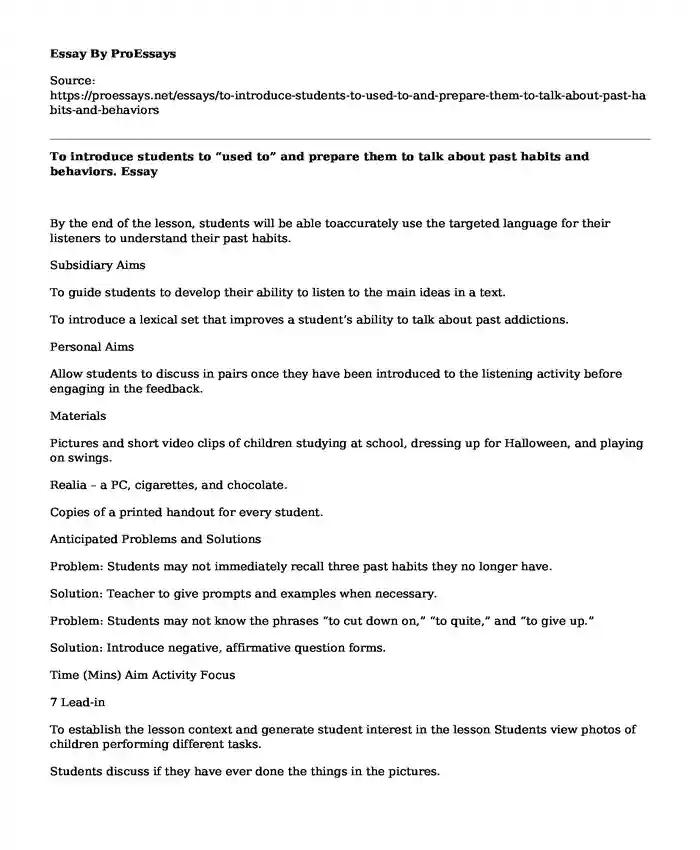By the end of the lesson, students will be able toaccurately use the targeted language for their listeners to understand their past habits.
Subsidiary Aims
To guide students to develop their ability to listen to the main ideas in a text.
To introduce a lexical set that improves a student's ability to talk about past addictions.
Personal Aims
Allow students to discuss in pairs once they have been introduced to the listening activity before engaging in the feedback.
Materials
Pictures and short video clips of children studying at school, dressing up for Halloween, and playing on swings.
Realia - a PC, cigarettes, and chocolate.
Copies of a printed handout for every student.
Anticipated Problems and Solutions
Problem: Students may not immediately recall three past habits they no longer have.
Solution: Teacher to give prompts and examples when necessary.
Problem: Students may not know the phrases "to cut down on," "to quite," and "to give up."
Solution: Introduce negative, affirmative question forms.
Time (Mins) Aim Activity Focus
7 Lead-in
To establish the lesson context and generate student interest in the lesson Students view photos of children performing different tasks.
Students discuss if they have ever done the things in the pictures.
Students write three thing they did as children that they no longer do and give them to the teacher. S-S-S
8 Lexis
Teacher to introduce vocabulary to be used during the listening stage. Students observe a PC, chocolate, coffee, and cigarettes.
Students discuss how often they used each item.
The teacher introduces the terms addiction, addict, addicted, to give up, will power, and to quit. S-SS-ST-Ss
8 Listening
To introduce listening for context. Students listen to four people describe their past addictions.
Students are asked if they share in the addiction or if they had a different addiction. SSs-T
10 Presentation
A target language is introduced.
Teacher manipulates form.
The teacher provides restricted practice for students to use the target language and standardize their pronunciation.
The teacher introduces the target language by asking questions related to the habits mentions.
The teacher uses questions that elicit negative responses using the same addictions.
Teacher drills the target language Ss-T
8 Less retracted practice The teacher notes down one habit each student had as a child.
Students share what they used to do as children. T-Sss-S-SSs-T
5 Less restricted written practice
Introduce students to a written record of the target language. Students note down two sentences that capture their past habits and two about the habits of their friends.
The teacher collects feedback from students. S
14 Authentic practice
Introduce students to authentic practice with the target language. The teacher distributes handouts.
The teacher walks around the classroom, asking questions based on prompts. S-S-S
References
Abdallah, M. M. S. (2019). TEFL/TESOL Methodology 2: Advanced Language Teaching/Learning Strategies . Online Submission. https://files.eric.ed.gov/fulltext/ED596113.pdfCondrat, V. (2019). Tackling the conceptual issues in language educaiton: do we develop skills or competences?. In Professional Development in Language Contexts: Perceptions and Practices (pp. 53-62).
Dewi, R. S. I. Improving teachers'lesson plan through implementation of problem-based learning for tefl in ikip veteran semarang. ELT in Asia in the Digital Era: Global Citizenship and Identity, 114. https://d1wqtxts1xzle7.cloudfront.net/60708092/PROCEEDINGS_ASIA_TEFL_201720190925-20210-g7aez8.pdf?1569479924=&response-content-disposition=inline%3B+filename%3Dii_ELT_in_Asia_in_the_Digital_Era_Global.pdf&Expires=1607758315&Signature=DAyQvS2mdtuGCXjZbOug8kk3arB7pYx6j7ZrMZpjwUTDVB24UJQlPmG0I6di4FBZBvFbF~UOmY~wKpHKsncs1P2Sc6-6-nDfv7GNJGNGjlFKhALFNJjmuqeET9pI4yoUzL7KVetbf4kXq1m8GiPGiJzmJjoyDkPQCkl2sIAxEZGFJ4w6ORxLLgC0KlJtgX3JnySNrc2KpkrSqt~9Dj1t5Is0EmblxjPU6yK83u0oVoqYth1Ex88OSKq8dKZnG6J~vjf4ngnLmJ23nji95kXHE~jTr~b3c7dFba2tmO3OdiD1QzfOmECVYt8jqmEVBwm6BgES-aILVmTusfZdDpx~sA__&Key-Pair-Id=APKAJLOHF5GGSLRBV4ZA#page=128Rejeki, S. (2017). Approach and Methods on TEFL: Inquiry-Based Language Learning (IBLL). ENGLISH FRANCA: Academic Journal of English Language and Education, 1(2), 135-148. http://journal.iaincurup.ac.id/index.php/english/article/download/154/177
Cite this page
To introduce students to "used to" and prepare them to talk about past habits and behaviors.. (2024, Jan 29). Retrieved from https://proessays.net/essays/to-introduce-students-to-used-to-and-prepare-them-to-talk-about-past-habits-and-behaviors
If you are the original author of this essay and no longer wish to have it published on the ProEssays website, please click below to request its removal:
- Paper Sample on Need and History of Affordable Care Act
- Chemical Household Products Leads to Wheezing in Children Essay
- Research Paper on Strengths and Weaknesses of Government Nutrient Recommendations
- Advantages of Electronic Health Records in Healthcare - Research Paper
- Coronavirus: US Neglects CDC Precaution, Trump Refuses Mask - Essay Sample
- 2020: The Year Corona Virus Changed the World - Essay Sample
- Essay Example on Diagnosis and Treatment of Community-Acquired Pneumonia in Patients with Acute Cough







